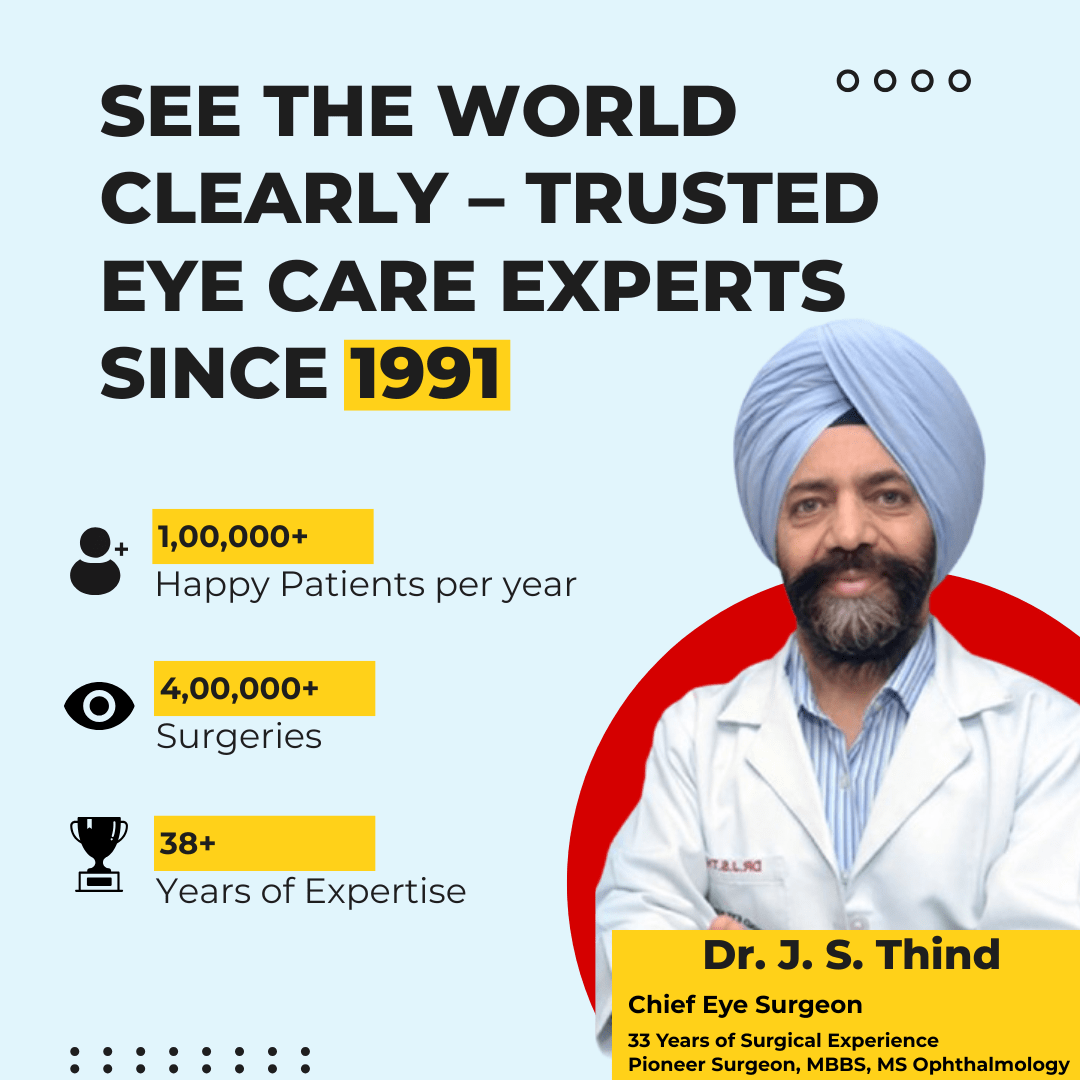As people age, vision changes are nearly inevitable. One of the most common age-related vision issues is presbyopia, a condition that affects the eye’s ability to focus on close objects. If you’ve recently found yourself holding reading material at arm’s length or struggling with fine print, presbyopia might be the cause.
Fortunately, presbyopia treatment options have advanced significantly, offering effective solutions for clear and comfortable near vision. At Thind Eye Hospital, our senior eye care team and the best ophthalmologists in Jalandhar are dedicated to helping patients maintain sharp vision well into their golden years.
In this article, we’ll explain what presbyopia is, its symptoms, how it can be treated, and what steps you can take to slow its progression.
1. What Is Presbyopia and How It Affects Aging Adults
Presbyopia is a natural part of the aging process that typically begins to affect people around the age of 40. It occurs when the lens inside the eye becomes less flexible, making it harder to focus on nearby objects.
Unlike other refractive errors like myopia (nearsightedness) or hyperopia (farsightedness), presbyopia is not caused by the shape of the eyeball but by the gradual stiffening of the eye’s lens. The condition worsens over time, making it increasingly difficult to perform tasks such as:
- Reading books or newspapers
- Using smartphones or computers
- Sewing, knitting, or doing detailed crafts
Presbyopia affects everyone eventually, regardless of whether you’ve had perfect vision previously.
2. Common Symptoms of Presbyopia
While the onset is often subtle, the symptoms of presbyopia can become bothersome if left unaddressed. Here are some signs that you might need presbyopia treatment:
- Blurry vision when reading up close
- Needing to hold reading material farther away
- Eyestrain or fatigue after prolonged close work
- Frequent headaches, especially after reading
- Difficulty reading in dim lighting
If you’re noticing these issues, it’s time to consult an eye specialist near you. Timely diagnosis can help prevent unnecessary discomfort and enable you to maintain productivity and quality of life.
3. Treatment Options: Glasses, Contact Lenses, and Surgery
The good news is that presbyopia is easily manageable. Modern vision correction techniques allow patients to regain clear near vision with a range of customizable solutions.
- Reading Glasses: These are the simplest solutions for those with otherwise good distance vision. Over-the-counter options are available, but prescription lenses tailored by an eye specialist offer better accuracy and comfort.
- Bifocal or Progressive Glasses: For individuals who also require distance correction, bifocals or progressive lenses are ideal. Bifocals have two distinct sections for near and distance vision, while progressives offer a more seamless transition between vision zones.
- Contact Lenses: There are multiple contact lens solutions for presbyopia, including:
- Multifocal lenses: Allow for distance and near correction within one lens.
- Monovision contacts: One eye is corrected for distance and the other for near, which the brain learns to coordinate.
- Surgical Options: For those seeking long-term solutions, surgical treatments for presbyopia are becoming increasingly popular.
- Refractive Lens Exchange (RLE): This involves replacing the eye’s natural lens with an artificial intraocular lens (IOL) similar to cataract surgery.
- Corneal inlays: Small devices implanted in the cornea to improve near vision.
- LASIK for Presbyopia: Specialized LASIK procedures can create monovision correction, although this may not be suitable for everyone.
At our ophthalmology clinic in Jalandhar, we offer advanced diagnostic tools to assess your suitability for these surgical options and ensure you receive the safest and most effective treatment.
4. Preventing or Slowing the Progression of Presbyopia
Although presbyopia is a natural part of aging, certain lifestyle habits and care strategies can delay its onset or reduce its impact:
- Protect Your Eyes from UV Light: Long-term exposure to UV rays can accelerate the aging of the eye’s lens. Wear sunglasses that block 100% UVA and UVB rays.
- Use Proper Lighting: Avoid reading in dim or excessively bright light, both of which can strain your eyes.
- Follow the 20-20-20 Rule: Every 20 minutes, take a 20-second break and look at something 20 feet away. This reduces eye fatigue and preserves focusing ability.
- Eat for Eye Health: Nutrient-rich foods—especially those high in antioxidants, omega-3 fatty acids, and vitamins A, C, and E—support eye health and may slow degenerative changes.
- Regular Eye Exams: Routine check-ups are vital. Presbyopia is progressive, and your prescription may need frequent updates. Annual visits to an eye specialist near you ensure optimal vision and timely treatment.
5. Book an Eye Specialist Appointment for Presbyopia Treatment
At Thind Eye Hospital, our team of the best ophthalmologists provides comprehensive care tailored to the unique needs of aging eyes. Whether you’re just beginning to notice symptoms or are looking for advanced vision correction solutions, we’re here to help.
We are recognized as a top-tier senior eye care provider in the region, offering:
- Custom prescriptions for presbyopia
- High-quality progressive and multifocal lenses
- Advanced contact lens fittings
- Surgical consultation for long-term treatment
- Personalized guidance for eye care in later life
Take Control of Your Vision Today
Presbyopia doesn’t mean you have to struggle with daily tasks or give up your favorite hobbies. With the right support and modern treatment options, you can enjoy clear, comfortable near vision at any age.
Book your eye specialist appointment at Thind Eye Hospital, the trusted choice for presbyopia treatment and senior eye care in Jalandhar.


